Letting the Vineyard be the Star
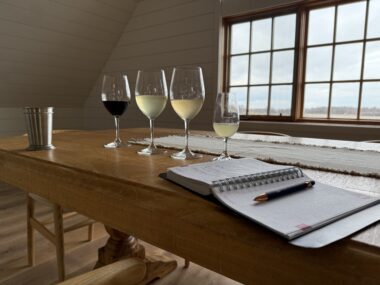
While cleaning out my desk recently, I opened up a day-timer from 2008 and was instantly transported back to a life I scarcely remember. It was a time when we were on the cusp of something special, but I didn’t know it yet. There were notes from introductory meetings with Insite Design, a honeymoon in Paris and Burgundy planned without a smartphone, a golf trip with my Dad to Williamsburg and some ideas for the name of a winery. “How many rows of Pinot did Mom and Dad first plant back then?”
Fittingly, thanks to those fruitful sessions with Insite, just about the only thing that hasn’t changed over the last 17 years is our wine label. To put things into context, you have to remember that blogs were cutting edge back then and my idea of “social media” was an email exchange with Peter Mansbridge about his enjoyment of our Pinot Gris. Ultimately, the exercise was a fun reminder about why we got into this in the first place along with the early challenges and uncertainty that we faced.
One odd note I came across was a page that simply had the words “letting the vineyard be the star” written on it. I don’t remember the context or what I intended to do with that thought, but perhaps it has been a silent mantra engrained within me throughout this whole journey. Maybe it was a humble reminder that it’s not meant to be about me, but a tribute to those whocame before. More likely, I was attempting to manifest a situation where everything revolved around what happened in the vineyard – the blog stories, the wines, my daily farm work and meeting people for tastings in the barn. Come to think of it, maybe that part hasn’t changed much either.
In an era where the look at me culture fostered by many social media platforms becomes the new norm, it can be difficult to trust that the way you have always done things still resonates. Seeing that statement, on a page written in 2008, was just the perspective tonic I needed to keep letting it happen from the vineyard out.
2022 Pinot Noir
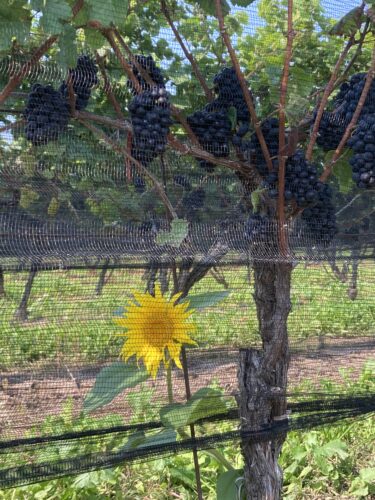
2022 Pinot Noir
I’m not sure how many people’s Mom’s taught them everything they know about growing Pinot Noir, but consider us a lucky few. Yes, one of the things that makes Five Rows unique is the passed down love of working in a vineyard. Nowhere is that more the case than in our old Pinot Noir block.
It is inspiring to read so many stories these days celebrating the critical role played by women in the development of our industry, and it makes me proud to know that my Mom has been doing her part for over 40 years. Early on, it didn’t take her long to realize that growing Pinot Noir would present a very different challenge to the hybrids and labruscas that she was accustomed to tending. Like many other vinifera converts at the time, my parents were forced to re-learn grape growing on the fly, her in the vines and he on the tractor. Thankfully, I got to observe them both as I grew in step with those first Pinot vines.
My sister and I were raised on the forefront of a changing industry. Everything that Ontario grape growers and wineries did in the 1980s was new and understandably questioned by the establishment. It is a much different experience for our kids 40 years later – the industry is established, respected and much larger. You might say they have it a little easier, but growing Pinot Noir is still as challenging as it ever has been and I can’t wait to pass that on…in a good way!
Although not as severe as seen in other varietals, the usually hardy old Pinot Noir vines were not spared the winterkill damage of 2022. This meant significantly lower yields and more attention paid to vine balance and nutrient status within the block throughout the vintage. Excellent summer growing conditions made for few issues in ripening that light crop, which was harvested on September 24th.
Normally, I would choose entire rows to harvest for our production, but the sporadic crop distribution necessitated a different approach. It was decided to use portions of many rows as opposed to whole rows, and for that reason the 2022 Five Rows Pinot is perhaps the most representative exploration of terroir over the entire Old Block we have made to date.
Tasting notes:
Good colour for Lowrey Vineyard Pinot Noir. Refreshingly intense, ripe red fruit component (wild strawberry, cherry). The subtle oak is mainly perceptible on the palate, showing harmonious integration. An underlying hint of terroir-defining truffle/mushroom supports the bright fruit. Pleasing tannins that do not overwhelm the palate, quite the opposite, inviting one to envision what the future might hold for this wine, this vineyard.
2024 Sauvignon Blanc
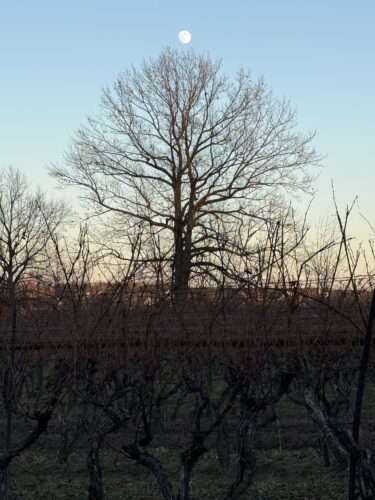
2024 Sauvignon Blanc
“The Infinite Variability of Terroir”
One day, while inspecting the hundreds of new replants in our Sauvignon Blanc vineyards, I was struck by the vast number of variables that are at play behind the creation of any wine. As I peeked into the grow tubes, one by one, to check on the status of these struggling little sticks in the ground, I couldn’t help but be awed by the evolving and tangled web of life that is a vineyard.
When you really think about all of these variables on a micro level (berry cells, leaf chlorophyll, root growth, soil micronutrients and the intensity of radiation on August 21st at 2pm – just to name a few) it can make your head spin. It’s a wonder that any two wines ever show any similarity whatsoever!
Enter the winemaker. They have the tools to mold a wine into a certain style through their choice of barrels, yeast, nutrients and malolactic bacteria. Alternatively, they may choose to let the anomalies of each vintage shine through by minimal intervention. This latter approach is my preference, adding even more layers to the seemingly infinite variability of terroir.
The vintage of 2024 may one day be celebrated as one for the ages. That is much easier to proclaim now, of course, than during the vintage itself. Contemplating all the things that have to go right for a successful harvest is far more enjoyable after the fact than during the ordeal. Unlike other standout vintages where the eventual outcome was more obvious early on, 2024 had its share of extreme precipitation events that left our fields flooded in a way we had never experienced before. The prevailing thought at the time was that the excess precipitation would have a negative effect on fruit quality. Much like 2023, however, the crop was saved by perfect ripening conditions in August and September.
I’m not sure if birds would be classified as part of the terroir, but they certainly played a part in thinning the Sauvignon Blanc crop this vintage, especially in the northernmost section of the block. This was yet another anomaly that we had never encountered with this varietal in that specific part of the vineyard. You may sense a theme here.
The fruit for this wine was harvested from both of our Sauvignon Blanc vineyards on September 11th, with ripening parameters of 20.8 ºBrix, TA 7.35 and pH 3.32. After pressing, the juice was fermented in a combination of mostly neutral French oak barrels (85%) and tank (15%). The fermentations were managed to be as slow and cool as possible for maximum aromatic and flavour potential. Along the way, the wine picked up pronounced citrus and herbaceous notes, subtle tropicality and hints of lemongrass.
The terroir is strong here, both in its familiar hallmarks and vintage specific nuances.
2022 Cabernet Sauvignon
2022 Cabernet Sauvignon
I operate under the assumption that everything I do in the vineyard will slightly improve the wine. There is a belief that I will make better, truer wines by being present in my vineyard every day. The moment I entertain doubt, I lose confidence and motivation. Sometimes growing Cabernet Sauvignon in a cool climate can foster those feelings of doubt, as no varietal that we grow is more dependent on the length of the growing season and warm fall conditions.
Perhaps that is why I have mixed feelings about naturally light crop vintages like 2022. On one hand, a lower yield is just what the doctor ordered for ripeness and tannic maturity in your fruit. On the other hand, it could be proof that we tend to overcrop our Cabernet Sauvignon in most other seasons, leading to unplanned late season crop adjustments. Either way, it always comes down to the amount of growing degree days experienced by that crop (heavy or light) in a given season and there is little you can do to influence that!
The 2022 vintage turned out to be a dream season for low-yielding Cabernet Sauvignon in Niagara. We ended up with some of the ripest Cab we’ve cultivated to date (24.4ºBrix) on one of our earliest harvest days ever (October 16th). Fruit for this wine was sourced from both of our clones, 169 and 191. Each block was hand-picked and gently destemmed into its own bin. The wine was allowed a four-day cold soak before indigenous yeast fermentations started naturally, then were managed with three daily punchdowns. The wine was dry after five more days with a peak fermentation temperature of 32ºC.
Given the ripeness of the fruit, I remained cognisant of the potential overextraction of tannins throughout the fermentation process. I made it a habit to taste each bin daily to evaluate the mouthfeel, noting if there was any significant change to the tannic profile. When all the elements felt balanced, we opted to lightly press both bins in our traditional small basket presses.
Four French oak barrels (25% new oak) housed the wine for two years and what evolved was a truly special wine. It is expressively aromatic, even in its youth, and shows equal parts depth and approachability on the palate.
There is no doubt about it, I grow Cabernet Sauvignon to make wines like this.
2022 Syrah
2022 Syrah
My perspective on growing Syrah is a complicated one that has shifted over time. Winterkill vintages, like 2022, are a reminder of just how tenuous this whole business can be. An entire vineyard that holds only 15% of its normal yield is a depressing challenge that can lead one to question the worthiness of the pursuit. However, the fact that there is any fruit at all is a blessing compared to the travails faced by those in the Okanagan, who’ve lost everything in recent years.
I’ve come to learn, through the process of trying to source replacement Syrah grapevines in a time of high demand, that the clones we currently grow are a dying breed. Nurseries are hesitant to propagate Clone 100 or Clone 7 these days, due to their likelihood of developing a foreboding (and aptly prophetic) grapevine disease known as “Syrah Decline”. Moreover, Syrah was not included as one of the acceptable varietals to plant in a recent Government funded vineyard replacement initiative. Key evidence that industry stakeholders do not view it as a financially viable option to grow in our region.
With so many strikes against Syrah one is left wondering, “is the juice worth the squeeze?”
Well…of course it is!
The 2022 Syrah crop was one of cleanliness and quality, thanks to a trend of dry weather in the late September days of that vintage. The precious few hanging clusters ripened optimally in those conditions and started to show signs of desiccation and concentration by the time they were ready to harvest on October 11th. The final tally was 84 picking boxes (1008 kg), with the majority of the fruit being sourced from the Clone 100 block.
The entire crop was fermented together in one bin for twelve days, with three daily punchdowns and a pretty hot peak temperature of 35°C. The Syrah was then gently squeezed in our antique basket press after two full weeks on the skins. Three French oak barrels were then filled, where the wine was allowed to undergo malolactic fermentation and mature for two years. 66 cases were bottled on April 17th, 2025.
The hallmarks of Syrah grown in a cool climate are on full display here: dark fruit, peppercorn, smokiness and smooth texture all in harmony. Any dish of wild game or hearty ragù would make a great pair for this wine. I would expect even more fruit intensity over the next few years in bottle, based on the evolution of previous small yield vintages.
I treat every year that I can put Syrah into a bottle, however small the quantity, like a gift from the vineyard Gods.
2024 Pinot Gris
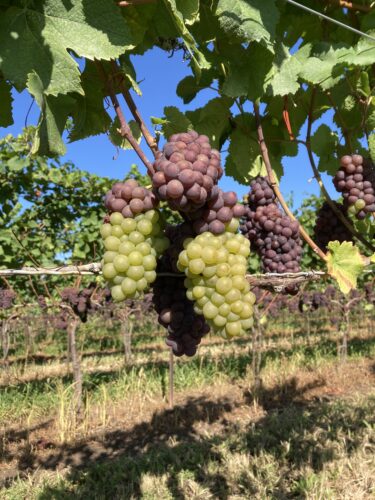
2024 Pinot Gris
For as long as I can remember, I’ve had a passion for organizing. My youth bedroom was a shrine of toys and sports memorabilia that I cherished and methodically categorized. Toys were for displaying and keeping in meticulous condition, while actually playing with them was an afterthought. Everything had its place and I was happy. Marie Kondo would have been proud of me.
In grade school, I thoroughly enjoyed creative writing. However, when faced with the task of writing a story, I much preferred the process of editing to the actual creative endeavour of coming up with original content. Being able to massage a sentence into something borderline coherent still gives me great joy. I am no wordsmith, perhaps more of a “wordslayer”.
One area where this penchant for organizing and editing has served me well is the many hours I’ve spent tending to Pinot Gris grapevines over the last 20 years. When embarking on an adventurous journey down a row of Pinot Gris, the mindset one must adopt is “survive and advance”. There is a gradual process to canopy management and thinning that can wear on those in need of instant gratification, so it pays to enjoy each vine along the way.
The ultimate goal is a well-spaced, vertically growing canopy with two uncrowded clusters per shoot. It will take multiple passes down a row to achieve this preferred arrangement, so it’s advisable to focus on a single task with each trip. In my experience Pinot Gris is the most difficult varietal to tame, as it has a tendency to flop over, grow laterally and create “clumps” wherein many clusters are growing tightly together. Tackling the shoot thinning first, then shoot positioning (tucking), followed by cluster thinning is the usual order of business. A careful removal of leaves in the fruiting zone is a late season finishing touch.
The grapes for our 2024 Pinot Gris are sourced from two different blocks on our farm. The older block, a 2004 planting of Clone 457 rootstock SO4, tends to be more vigourous and wild, but fairly predictable in regard to flavour production once properly organized. The younger block of Clone 53 rootstock 3309 was planted in 2019 and is still in the discovery phase. The vines seem more amenable to my efforts, with slightly looser clusters that are more robust to disease pressure. The initial crops have been light and VERY ripe, providing a nice complement to the older block fruit.
The crop from both blocks was harvested on September 11, 2024. Pressed juice was notably flavourful and came in at 21.2ºBrix, TA 7.13 and pH 3.38. Two-thirds of the juice was fermented in neutral French Oak barrels, with the remainder housed in tank. The cool temperature fermentations spanned September 17 to October 17, gradually accumulating the familiar Pinot Gris aromatics of canned pear, dried apricot and honey. The most noticeable contribution of the Clone 53 block is in the added aromatic intensity and more complex mouthfeel elements.
To know that vines you personally organized, provided the fruit for a wine that you created and edited into its optimal form, is the ultimate in satisfaction.
2024 Riesling
2024 “Jean’s Block” Riesling
Let’s face it, there are very few things in life that we can comfortably rely upon. The constant expansion of the Universe, the predictable enthusiasm of a Golden Retriever and the aromatic intensity of Riesling are just a few examples that immediately come to mind. I’ll tackle the origin of Riesling aromatics here and leave the other two phenomena for you to ponder at your leisure.
The Riesling story always begins in the vineyard, with clone choice and terroir. In most instances, choosing the best clone for your site is a strategic exercise of thorough consideration, while other times a shipping container mysteriously gets “lost at sea” and you take what you can get. The planting of Clone 49 Riesling on our farm falls more into the latter category, which I now consider a stroke of luck. The well-drained, clay loam soils bordering the Four Mile Creek proved to be a perfect home for this finicky, Alsatian clone.
While we may not have the dramatic slopes and altitude of its clonal homeland, our unique St. David’s Bench climate and terroir somehow manages to spoil us with expressive Riesling aromatics on a yearly basis. Channeling my inner Alsatian farmer, the focal points early in the growing season are crop level and canopy management. I’ve come to learn that Clone 49 can be cropped on the heavier side, providing the canopy is healthy and green. Fruit exposure decisions are made later in the season based on disease pressure, water status and weather trends.
In 2024, we faced a summer of extreme precipitation events, leading to a fuller canopy and an average size Riesling crop. It was decided to remove a few leaves in the fruiting zone at veraison to air things out a bit, but care was taken not to overexpose the fruit and compromise our preferred style. Prospects were looking good in the Riesling through August and early September until a stretch of typical harvest-time humidity. Windless, humid days and foggy mornings made it impossible for the vines to dry out properly and in quick succession botrytis spores began multiplying on the surfaces of our soaking clusters. We opted to harvest (in the nick of time!) on September 27th with ideal juice numbers of 18ºBrix, TA 8.6 g/L and pH 3.06.
It was apparent early on in the fermentation process that the aromatic potential was high – i.e. you could distinctly smell the fermenting Riesling as you pulled into the barn parking lot. I prefer to ferment my Riesling in tank with W15 yeast at a very cool temperature (9-10ºC) to preserve the bright fruit components, eventually stopping the fermentation before reaching complete dryness at a specific gravity of 1.004.
The resulting wine showcases standout notes of candied green apple, citrus, peach and perfumed floral undertones. It also features palate-awakening acidity and just enough residual sugar to achieve harmonious balance. In other words, everything that I’ve come to love about Clone 49!
2021 Pinot Noir
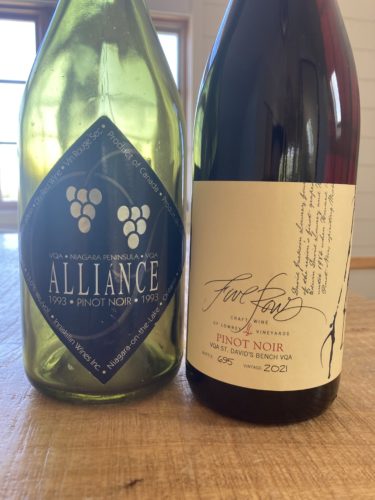
2021 Pinot Noir
The 2021 growing season, and the red wines that resulted, are a study in contrast and perseverance. In my vintage notes for the 2021 Pinot Noir there is written but one telltale comment, “One of those years.”
As a varietal Pinot Noir presents inherent contradictions. In the vineyard, it is a grape that requires intense labour, constant attention and a heavy hand, at times, to properly manage the canopy. In the winery, conversely, I’ve come to learn that restraint, patience and a gentle approach are critical to successfully translating terroir.
So that is why, given the difficult fall conditions of 2021, I took a different attitude toward crafting my Pinot Noir. Instead of lamenting the breakdown of clusters and writing off the vintage, I took the long view. Past vintages (and wiser winemaking colleagues than I) have taught me that the final sprint to cut out all of the rotten clusters and berries is not the end of the game, but actually just the end of the first half. I’ve been witness to many great late-game comebacks in my life, mostly against my rooting interest, but this could represent a moment of redemption!
So it was with guarded optimism that we harvested our Pinot Noir on September 21st, surely to get them off before the next imminent downpour. The ripening parameters were to my liking, but the field was soaked and my time was limited to cull out as much rot as possible prior to the handpick. I conjured up my best Edward Scissorhands, minus the Johnny Depp looks, and set to work.
Once the fruit was picked, sorted and gently destemmed into one tonne bins, they were sealed for a four-day cold soak. It is normally my hope that the wild fermentations would kick off right after the fourth day, but that is rarely the case. Thankfully, in this instance the stars seemed to align and when I cracked the bin lids on day four, I was greeted with a nice firm cap of skins and whole berries and the wonderful smells of a burgeoning fermentation. We were off to the races; the comeback was afoot!
Indigenous yeast fermentations can be a wild ride at times, but those driving the 2021 Pinot bins were models of consistency and aromatic beauty. Must temperatures hovered around 20C and peaked at 32C, and the bins were dry in seven days.
The bins were lightly pressed, then racked into five French oak barrels. This is where the restraint and patience are put into practice. Aside from the odd tasting session and biannual racking, there is not much to do over the next two years providing the wines are sound.
The final barrel tasting and blending sessions are the make or break moment when everything is on the line. So many combinations, so many possibilities, it can send your mind in many different directions. Some wines, however, present clarity in those moments and that was the case for the 2021 Pinot. It ended up being “one of those years” when the cooperage variables of barrel age, forest, grain tightness and toast level all line up in sync with the wine. The result is a wine that stars the terroir, while the oak and the winemaker play the supporting role.
Sometimes you just have to trust that the vineyard can be the hero in the end.
2023 Sauvignon Blanc

2023 Sauvignon Blanc
As the first buds of 2023 started to push from their winter cocoons, the countdown was on to see whether the fickle new trunks we painstakingly established the previous summer were up to the task of supporting vegetative growth. It was a nervous, yet fascinating time to observe the delicate first spring growth of a Sauvignon Blanc grapevine.
We didn’t have to wait long. The one thing about young trunks (young anything for that matter) is that they are vigorous and impatient. Two years’ worth of underutilized nutrient supply awaited the voracious and deep roots of these vines. Early season conditions were very conducive to growth, so much so that efforts were soon undertaken to balance the number of primary shoots on each new trunk. It can be difficult to summon the aggressiveness required when thinning these vigorous canes, especially the year after a light crop, but the alternative is a crowded and unruly canopy – no thanks!
The rebound season stretched on through the summer months, with more than adequate precipitation to support the now thriving vines. It became apparent that we were dealing with a bumper crop of large-berried clusters, so extra attention was paid to achieving proper fruit exposure and cluster spacing to combat fungal growth. Thankfully, a relatively dry and cool September resulted in super-clean fruit. The deficit in precipitation seemed to dilute the water status in the berries to the point where the intensity of flavours was more noticeable in the week leading up to harvest.
We chose to harvest our bountiful crop of Sauvignon Blanc on September 25th, and ended up with about 2300L of juice after the press cycle. After cold-settling the juice, it was racked into eight French oak barrels (80%) and one tank (20%). The barrels were of varying ages (2-15 years) and mostly neutral in their tannic contribution.
The vessels were warmed to 20°C and then inoculated with X5 yeast. Once fermentations were established, the barrels were cooled to 8°C for about two weeks, then allowed to warm again to finish. I find that pushing the lower end temperature limits of the yeast tends to maximize the aromatic intensity. One must be cautious, however, not to overly stress the yeast – it’s a fine line!
The finished wine represents an amalgam of all the terroir-derived elements that Sauvignon Blanc enthusiasts would come to expect. It is less overtly opulent than the light-crop 2022 vintage, putting it more in line with a typical vintage like 2019 or 2021. Aromatically, there is an intense intermingling of tropical and citrus characters, with some typical Sauv Blanc gooseberry present as well. The TA for this wine is 7.9 g/L, which balances well with the 8 g/L of residual sugar and contributes to noticeable length on the palate.
This wine evokes a personal feeling of satisfaction and thankfulness, born out of the travails of re-establishing a beloved vineyard. Perhaps that is why I enjoy it so much. I hope this feeling of rejuvenation and joy is perceptible to all those that give it a try.
2021 Cabernet Sauvignon
2021 Cabernet Sauvignon
Tasting through Cabernet Sauvignon barrels early in their evolution can be a mouth-puckering challenge. The tannins at this stage tend to be bold and chewy, often times completely masking the subtle nuance of flavours. You are comforted in the knowledge that there is ample time for correction, with a full 24-30 months spent in barrel, but it is still a little disconcerting.
I can’t imagine having to make blending or culling decisions prior to that timeframe because I’ve seen so many “late” mouthfeel transformations during the last few months in barrel. Obviously, the tannic profile of the fruit and the oak strategy employed have a lot to do with those transformations, but it is definitely something I track in the wines made from our older blocks of Cab Sauv.
Enter our new planting of Clone 191 Cabernet Sauvignon.
The 2021 vintage marked the first fruit we were able to harvest from that 14-row, 2019 planting. There is a certain first crop mythology that floats about in wine circles that I’ve always been skeptical of. It goes that wine made from a first crop can be magical and mature beyond its years, then the field usually goes through some growing pains before finding itself again and establishing consistency.
In early barrel sampling sessions, the Clone 191 wine was noticeably smoother and had more discernable ripe red fruit flavours than the older block Clone 169 wine. So much so, that I was starting to become a believer in the whole first crop myth. I wouldn’t fully buy in until much later, when I witnessed the emerging dynamic between the two clones in the final blend. My expectation was that the older block wine would swallow up the new kid and assert its veteran dominance, but a pleasantly harmonious blend arose instead.
Featuring a combination of cherry, wild blackberry, flinty minerality and a subtle floral note; there is also an unforeseen component to the mouthfeel and structure of this Cab that can only be attributed to the new planting. I will be keen to see how this wine ages.
It’s hard for me not to emotionally personify the Old Block as a humble mentor that realizes its days are numbered and the torch must eventually be passed. Due to increasing rates of grapevine virus infection (red blotch and leafroll virus), winterkill and old age, our beloved original Cabernet Sauvignon blocks will gradually need to be replaced. It’s a bittersweet scenario, but it rekindles my excitement to work with new fruit and a yet to be determined potential. There are also good feelings associated with sustaining the vineyard for the generations to come.
